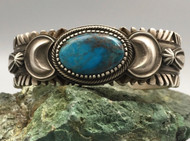What Kind of Turquoise
Posted by Jim Olson on Jan 25th 2018
One of the most common questions we get at the Trading Post is, “What kind of turquoise is this?” It’s a reasonable question. Many people would like to know the origin of the stone in their particular item. They ask us because, not only do we sell turquoise jewelry but we deal in turquoise as well. At any given time there is turquoise from about 15 different mines for sale at our store. I guess the public would think we are good ones to ask about the origin of a piece of turquoise. If there is one thing I’ve learned about experts however, it’s that if you ask ten experts for an opinion, you are going to get ten different opinions!
Honestly, mine identification (without provenance) is pure guessing. Educated guessing in the case of a knowledgeable person, but guessing none-the-less. Once that stone leaves the miner’s hands, the identification has to travel with it in order for one to be 100% sure of its origins. Unfortunately, once the stone is in jewelry, it often loses its identification as it passes from hand to hand. This is especially the case with vintage jewelry and the passage of time. When an item comes back around into the hands of a dealer who is offering it for resale, that seller is only making an educated guess as to the stone’s origin (unless provenance came with it).
For example, iron pyrite found in turquoise is indicative of only a handful of mines, so its presence can narrow down your choices greatly. Morenci and Kingman are two of the best known mines for having pyrite. However, there is pyrite in Mexican (and other) turquoise as well. Some have told me Sleeping Beauty never has pyrite, but others swear it occasionally does. Some people automatically say anything with pyrite is Morenci. Of course they would, out of all the mines known to have pyrite, Morenci is the generally the highest priced! So why wouldn’t they call anything with pyrite, “Morenci” (sarcasm).
Odds are however, if you have pyrite in your turquoise, it came from Kingman. Why, you ask? Simply because Kingman is so prolific, there is many more times as much of it on the market as any of the other possibilities. The odds are much greater. To tell the difference between the pyrite, color and other fine nuances between a piece of Morenci and a piece of Kingman, you have to handle hundreds and hundreds of pieces of it. But even then, it’s only an educated guess. One “expert” I read wrote that if there is quartz present with the pyrite, then it is definitely Morenci. However, another “expert” once told me that quartz present with pyrite means it’s Kingman! Now don’t get me wrong, there are many whose opinions I respect about turquoise origin, it’s just that they don’t always agree!
Another popular stone is Bisbee. Top tier Bisbee is well-known for its deep blue color and muddy-red host rock, or matrix. However, there are other mines which can throw similar looking turquoise. Naco, just south of Bisbee and over the Mexican border by a few miles is one place that has produced Bisbee look-a-like. China and Persia also produce some. Josh Colbaugh, of the Kingman mine, once told me, “Kingman can mimic almost any mine out there.” And then informed me about the numerous looks they have mined out of that one mine.
Sleeping Beauty is another popular mine. It is known for its sky blue color. Most Sleeping beauty has little to no host rock present. When it does show host rock however, most of the time it is white (like caliche). However, there is a lot of Sleeping Beauty set in jewelry that has black matrix! How does this happen? The host rock has been dyed black of course (it actually resembles classic Kingman with this look). And since Sleeping Beauty has become so popular, anything with a sky blue look to it has been called Sleeping Beauty by some. But other mines in the US, Mexico, Persia and China can throw off a similar looking turquoise. As mentioned above, some purist say that Sleeping Beauty never has pyrite present, but others swear once in a while it does.
There are a lot of generalizations thrown around at times. Green turquoise comes from Nevada. Blue from Arizona. Spiderweb from China. Dome cuts are from Persia. Light blue is Sleeping Beauty. Pyrite means it’s Morenci. Red host rock has to be Bisbee. On and on. So what do we believe?
One I laugh about is when somebody tells me that they have X in their piece of jewelry and when I ask how they know that, they say, “because an Indian told me that’s what it was.” I assure you, being a Native American does not make one an expert on turquoise any more than being from Wisconsin makes you an expert on cheese! An expert on turquoise gets that way by study and having an eye for it, not heritage.
In my opinion, somebody who has handled enough turquoise from different mines can get pretty good at being right most of the time. The top grade out of many mines is recognizable. The classic look that any particular mine gets known for can be learned and many (from all walks of life and ethnic groups) have spent years handling enough of it to be pretty good. Remember though, when someone who is an expert recognizes that certain look, he is still only giving you an educated guess as to what it is. It’s a better than a fifty-percent chance in most cases, but even the best are still only making an educated guess.
I once had a lady bring in a box of turquoise to sell. When asked what she knew about it, she told me it was from Bisbee. I looked in the box and it looked like Sleeping Beauty (light blue) and a generic green (could be from anywhere) turquoise to me. It had none of the indicators of classic Bisbee. I questioned the lady further and she said her dad had been an operator at the Bisbee mine for many years. These were samples he had confiscated from the job site. When I told her it sure didn’t look like Bisbee, she swore there was no other possibility. After a bit more conversation, I realized this lady was probably telling the truth. She was not asking for a premium on the turquoise because it was Bisbee. As a mater of fact, she did not even know there was a price difference between Bisbee and other turquoise. She even showed me pictures of her dad on a large loader at the mine. She simply wanted to sell some light blue and green turquoise that she inherited from her dad at what ever the going price was. Period. It reminds me that most any mine (especially the larger ones) can throw off numerous different looks besides the one they get known for.
A couple years ago there was a fellow (who I will keep anonymous) that was selling groups of Morenci, Bisbee, Kingman and Sleeping Beauty turquoise. He had it all sorted out by mine, in nice little trays. Light blue - Sleeping Beauty. Dark blue with reddish matrix - Bisbee. Medium blue - Kingman. Dark blue with pyrite - Morenci. But as it turns out, this guy was actually selling Mexican turquoise! It had all came from the same general area in Mexico!
No article on turquoise is complete without mentioning Lander Blue, the rarest turquoise in the world. There was only about 100 pounds of it found and most of it was high grade. This is nice because a large percentage had a certain, similar look. It can be authenticated within reason (by only a few knowledgeable experts however). Because of its fine look and rarity, prices for Lander Blue are many times higher than other turquoise mines. This leads to some calling anything with dark blue dots of spiderweb turquoise and black host rock, Landers. Bob Brucia, of Nevada Gem and owner of the Lander Blue mining claim writes on his website, “Today, because of its rarity and value, there seems to be more Lander Blue for sale than was ever mined.”
A while back, a well-known turquoise dealer posted on Social Media, some pictures of Lander Blue turquoise he had found. I thought they really didn’t look right to me for Landers, but hey, what do I know, he’s an expert. Then, a few days later, he retracted his claim that they were Landers, saying that after conferring with some of his colleagues, he had been mistaken in his attribution. I thought it was pretty big of him to admit the mistake publicly, but it just goes to show you that everyone, even the so-called experts, makes mistakes.
I believe unless you are a turquoise expert or connoisseur, you should probably just buy what you like and don’t worry too much about what mine somebody thinks it is. Don’t pay extra for X if you do not know, or cannot tell, the difference between X and Y. Everyone has a different opinion on what appeals to them, so you should listen to your heart and buy what feels right for you. And if you are the person who collects high grade turquoise only, then you already know provenance is key. What stone is this? Does the seller know where this stone came from, or is he simply making an attribution? Of course, in any case, you will only want to deal with reputable sellers you can trust and who stand behind what they sell.
In the end, I usually tell folks that only God and the miner who dug the rock truly knows where any particular stone comes from. The rest of us are only guessing. Meaning, unless the person selling it has a trail leading back to the miner, he is only making an educated guess. And, as mentioned in the beginning, you will get many different opinions when asking people for their best guess. So educate yourself, read what the experts have written and listen to what they say. Then you will form an opinion of your own. Who knows, maybe someday you will be one of those frequently asked, “What kind of turquoise is this?”
For more interesting fact about turquoise, read this.
Jim Olson ©2018

